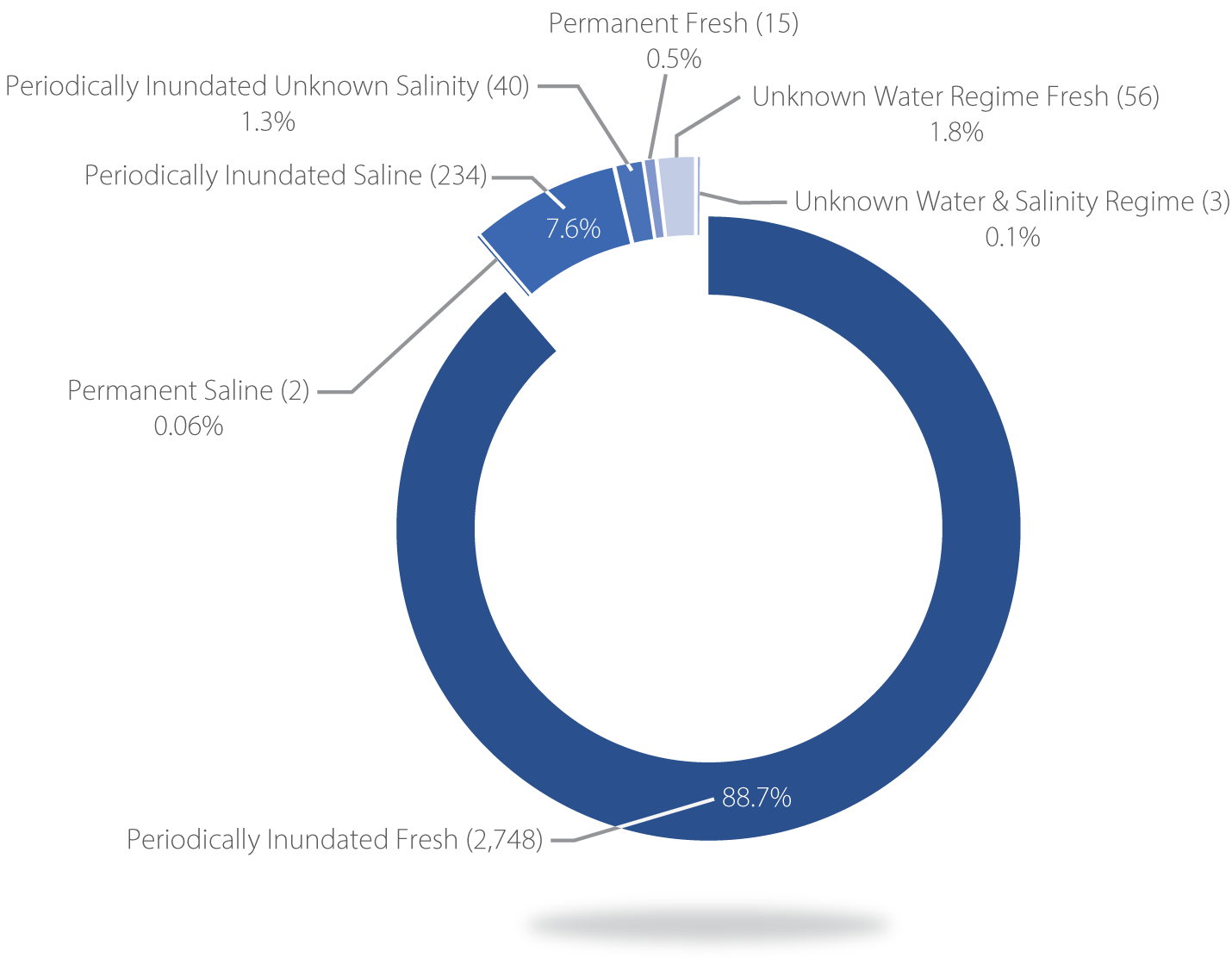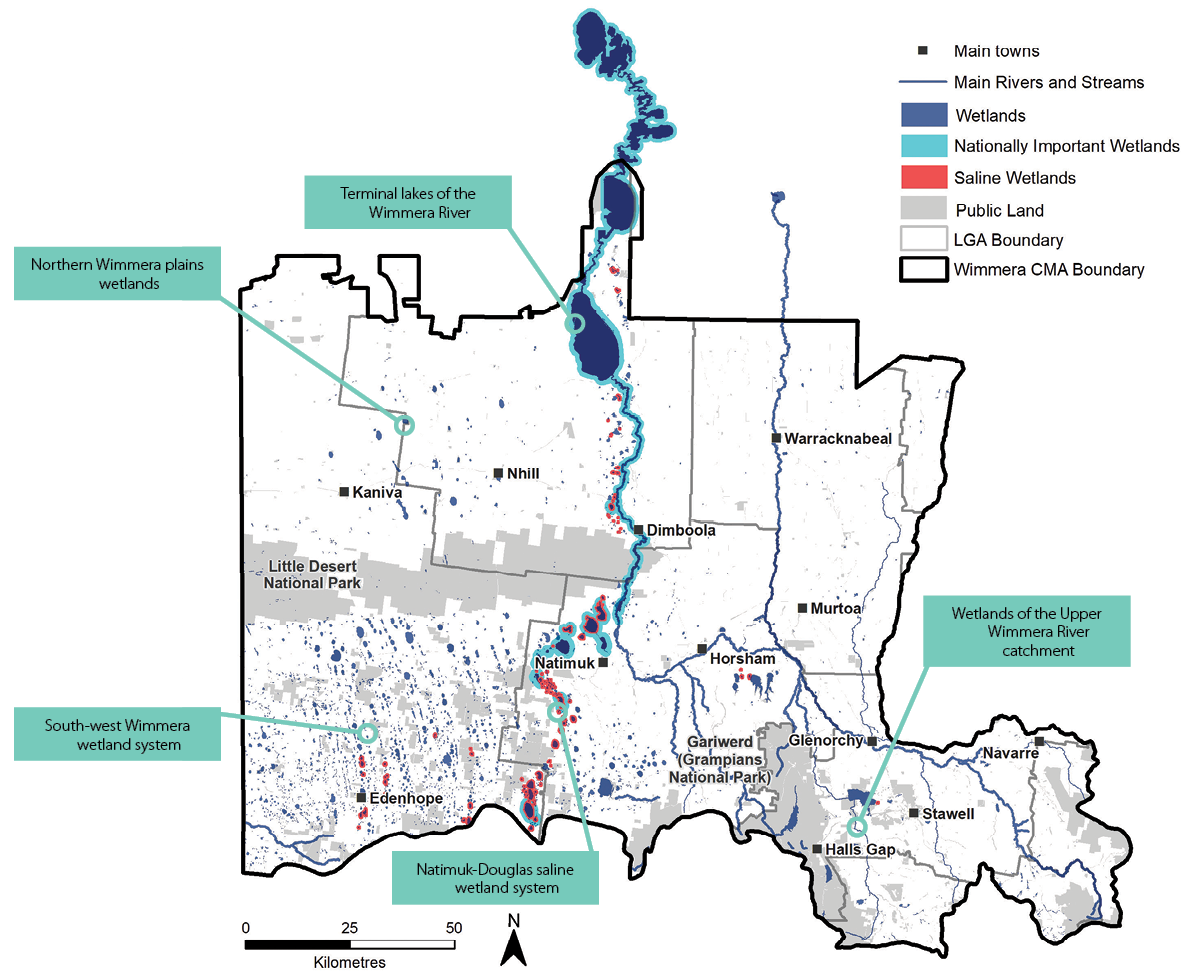| |||||
Most of the Wimmera’s wetlands contain significant cultural value. They provide significant resources and spiritual value for First Nations people. This ongoing connection is still reflected today. For example, a study in 2017 of Ross Lakes near Ngalpakatia/Ngelpagutya (Lake Albacutya) reidentified two middens and nine scar trees. It also discovered 32 new scarred trees, a rare carved tree, clay balls and middens. The report concluded that Ross Lakes was an important meeting place. It is clear by the age of some of the sites that this connection has remained.
Wetlands are highly diverse in terms of their hydrology and salinity. The Wimmera includes a range of fresh, shallow, seasonal and periodically inundated wetlands, more permanent deep lakes and shallow and deeper groundwater-fed saline wetlands (Figure 6). This contributes to high wetland biodiversity, with the different categories of wetland supporting a highly diverse mix of plant, bird, macroinvertebrate and other wetland species.

Figure 6: Number and percentage of wetlands greater than one hectare in size in each wetland category in the Wimmera
Most of the Wimmera’s wetlands are in the Millicent Coast Basin and dry up periodically. Only 1.5% of the region’s wetlands are categorised as permanent.(8)
The Wimmera is home to many Seasonally Herbaceous Wetlands (Freshwater) of the Temperate Lowland Plains which are listed as a critically endangered ecological community under the Commonwealth Environment Protection and Biodiversity Conservation Act 1999 (EPBC Act).
Ngalpakatia/Ngelpagutya (Lake Albacutya) is recognised as an internationally significant wetland via the Ramsar Convention. Gurru (Lake Hindmarsh) is Victoria’s largest freshwater lake and is listed as a nationally significant wetland. Both receive water from the Barringgi Gadyin (Wimmera River), via Outlet Creek for Ngalpakatia/Ngelpagutya (Lake Albacutya). The episodic nature of flows into these terminal lakes means that they can be empty for many years before floodwaters fill them for at least a couple of years, watering fringe vegetation and providing a haven for tens of thousands of migratory water birds. There are also several other downstream terminal lakes that rely on Ngalpakatia/ Ngelpagutya (Lake Albacutya) filling that they have not received water for at least 40 years.
Others such as Lakes Fyans, Bellfield, Wartook, Taylors Lake and Lake Lonsdale are important water storages and can provide some environmental values as well as important water resources for the region and beyond. For example, at low water levels Lake Lonsdale supports abundant waterbirds who enjoy the shallow water habitat.
The Wimmera’s wetlands support many plants and animals of international and national significance. Migratory birds are known to frequent the region to breed and the endangered regent parrot (Polytelis anthopeplus) inhabits the surrounds of Lakes Albacutya and Hindmarsh. Wetlands also play an important role in supporting waterbirds such as the plumed whistling duck (Dendrocygna eytoni) when there is drought in other parts of the country. They also support local bird migrations from the Victorian Coast to the Murray River and are home to endangered plants such as ridged water milfoil (Myriophyllum porcatum) and spiny lignum (Duma horrida).
Some wetlands, such as Pink Lake, Natimuk Lake, Oliver’s Lake and White Lake, are considered to be ecologically of national significance.(9)
Many of the region’s wetlands provide significant recreation opportunities, contributing economic and health benefits to the region when they contain water. Lake Fyans and Lake Wallace alone generate around $2.5 million and $1 million per year respectively for their local community through the events, tourism and recreation opportunities they provide.
Wetlands can be grouped into sub-regions or wetland systems based on similar geographic characteristics and management issues (Figure 7). The wetland systems and their key attributes include:
- Terminal lakes of the Barringgi Gadyin (Wimmera River)
- Including internationally significant Ngalpakatia/ Ngelpagutya (Lake Albacutya) Ramsar site and nationally significant Gurru (Lake Hindmarsh)
- Natimuk-Douglas saline wetland system
- Saline and freshwater lakes of global bird conservation importance
- Eleven wetlands are nationally important
- South–west Wimmera wetland system
- Major wetland complex, supporting high biodiversity
- EPBC Act listed Seasonal Herbaceous Wetlands (freshwater) of the Temperate Lowland Plains
- Northern Wimmera Plains wetlands
- Scattered wetlands in an intensively cropped landscape
- Pink Lake is nationally important
- Wetlands of the Upper Barringgi Gadyin (Wimmera River) catchment
- Scattered wetlands, regionally important water supply storages and recreational lakes

Figure 7: Wetlands and major wetland systems in the Wimmera
Assessment of current condition and trends
There has been a large and concerted effort over the past 20 years to improve the management of wetlands so they can continue to provide economic, social, cultural and environmental values. Many landholders have entered long- term funding agreements to protect and enhance wetlands with the support of government. Others have voluntarily fenced their wetlands to limit stock access and have managed invasive plants and animals. Hindmarsh Shire has introduced planning provisions to provide conditions that ensure appropriate development within wetland catchments.
Significant wetlands on public land have been managed for typical threats such as weeds and pest but have benefited in investment that has improved sustainable accessibility to the community, thereby improving their environmental, economic and social value. For example, in 2019-20 financial year, Lake Marma at Murtoa, generated more income for the local economy than in previous years despite COVID-19 because of the introduction of cabin accommodation.(6) Power upgrades at Lake Charlegrark near Minimay has enabled improved septic toilet management, reducing risks to water quality.
Despite this good work the condition of individual wetlands varies considerably. Many are in good to excellent condition, but large numbers have also been moderately to heavily degraded or lost. The trend in wetland modification is continuing but could be slowing. Analysis of data in 2017 shows that 23% of the region’s wetlands have no modification compared to 2004 when this was 44%. Assessment of 985 select wetlands in 2004, 2011 and 2017 shows that 118, 262 and 268 wetlands were cropped respectively, indicating that cropping of wetlands had not materially increased to 2017.(10)
Freshwater meadows are under the highest threat, with almost 400 lost since the 1970s. An assessment of data from 2017 indicates that only 195 of the 1,005 freshwater meadows in the region have no modification. Most of these modifications are drains and dams.(11)
Some wetlands are considered lost because they no longer function as wetlands, primarily due to being drained.(11) Condition assessments in 2005(12) and 2009(13) found wetland soils, hydrology and physical form to generally be in good condition. The condition of vegetation varied but a large proportion of wetlands were found to be in moderate condition. The wetland catchment was of highest concern, with 61% of assessed wetlands having catchments in poor to very poor condition, indicating poor ‘buffer areas’ immediately surrounding the wetlands and potential impacts from neighbouring land.
Nine per cent of the Wimmera’s wetlands are considered summer refuges. These wetlands often hold water long enough for species to go through a breeding cycle in dry years. Most (8.5%) are freshwater, meaning they are suitable for amphibians.(8) These wetlands are priorities for connectivity in the landscape in a drying climate.
An assessment in 2019 indicated that the relevant values of Ngalpakatia/Ngelpagutya (Lake Albacutya) were within the limit of acceptable change for its ecological character description despite not receiving flood water for many years and some decline in river red gum (Eucalyptus camaldulensis) health.(14)
Major threats and drivers of change
Changing hydrology is an issue with almost 63% of the region’s wetlands altered by a dam, drain or bank. This is an increase of 3% since 2011.(10) This changes the natural timing, duration and extent of flooding. These changes have occurred across the region, resulting in complete loss of some wetlands, while others are significantly altered.
Cropping can severely impact on wetland health by damaging wetland plants and impacting on water quality. Changes from traditional livestock management to cereal and legume cropping can decrease runoff and inflows to wetlands. Continual improvement to soil moisture retention techniques will likely increase this impact.(15)
Drought and drying climate leave wetlands susceptible to damaging activities like cropping and overgrazing. An assessment of climate change vulnerability for wetlands in Victoria found that, under worst case drying scenarios, the interval between wetland inundation events would increase from around once everyone to two years to once every four years.(16) However, wetlands should continue to persist in the landscape under other drying scenarios. Impacts on groundwater-fed wetlands are more challenging to predict, but a shift in water regime from seasonal to intermittent wetting is likely for at least some of these wetlands with consequent changes in wetland ecology. Wetland managers are unable to directly influence climate, but can influence activities that degrade dry wetlands, such as cropping and overgrazing.
Climate change can also impact the number of wetlands in chains that will be inundated. Depending on the speed of the change they may transition to a terrestrial ecosystem. For example, the Wirrengren Plain in the region’s far north has transitioned from displaying mostly wetland to terrestrial characteristics.
Pest plants found in wetlands and their fringing areas include bridal creeper (Asparagus asparagoides), perennial veldt grass (Ehrharta calycina), African boxthorn (Lycium ferocissimum), phalaris (Pharalis aquatic), tall wheat-grass (Lophopyrum ponticum), spear thistle (Cirsium vulgare), Yorkshire fog (Holcus lanatus), Scotch thistle (Onopodum acanthium), dock (Rumex spp.), small nettle (Urtica urens) and other pasture grasses.
Weed invasion can degrade wetlands by out-competing native plants and simplifying vegetation structure, providing harbour for pest animals such as the red fox (Vulpes vulpes) and rabbits (Oryctolagus cuniculus) and reducing aesthetic appearance.
Pest animals can negatively impact on native wetland plants and animals. Common wetland pest animals include predators like foxes, feral cats and dogs (Canis lupus familiaris); non native fish like carp and mosquitofish (Gambusia holbrooki) and grazing animals like rabbits and hares.
Grazing by stock commonly occurs in wetlands on private land. The impact on wetlands depends on the timing, intensity and frequency of grazing. In some cases, light well-timed grazing can benefit some types of wetlands. Overgrazing and poorly timed grazing can degrade wetlands, introduce manure and weeds and pugging, and compact and erode soils.
Because 90% of the Wimmera’s wetlands are located on private land they are not accessible to the broader community for recreation or cultural activities. This limits the community’s ability to maximise their social and economic benefit. There is also greater pressure on the wetlands on public land, many of which have inappropriate infrastructure to support sustainable access. For example, many lack formal tracks or access points.
Recreational impacts can impact wetlands. High intensity or inappropriate recreation can remove ground cover and cause erosion and sedimentation of wetlands and degraded water quality. This particularly impacts on deep permanent lakes that are popular for recreation. Litter can also impact on wetland habitat and reduce amenity.
Desired outcomes for the future
Outcomes to be achieved in 20+ years
- The knowledge and experience of First Nations people is informing wetland planning, management and delivery in the Wimmera.
- The values and condition of wetlands with recognised significance are maintained or improved.
- Connectivity and condition along priority wetlands systems is improved.
- Wetlands with high environmental, social, cultural and economic values are maintained or improved despite climate change.
Outcomes to be achieved in 6 years
- Ongoing collaboration and two way learning in wetland planning and management by supporting and strengthening partnerships with First Nations people.
- More privately owned wetlands have stock managed and cropping prevented.
- The condition of more wetlands on public land is improved.
- The rate of wetland modification and loss is reduced.
- Wetlands are monitored to ensure the condition and values of Ramsar and nationally significant wetlands are maintained and potential new listings are identified.
- No new pest plants and animals are established beyond small, localised populations.
- More wetlands are permanently protected through management agreements.
- More wetlands have improved management of and access for recreation.
- Recreational participation numbers on wetlands are increasing.
Complementary Plans
Wimmera Waterway Strategy
The Wimmera Waterway Strategy 2014-22 is an action plan for the Regional Catchment Strategy (RCS) designed to deliver actions which deliver the long-term and short-term outcomes for Wetlands. It identifies priority wetlands and includes a detailed set of management targets for each priority.
Wimmera Strategic Directions Statement
The Wimmera Strategic Directions Statement outlines the priority integrated water management projects for the region. They are designed to improve the liveability and sustainability of the region’s towns and city by implementing improvements to the regional water cycle. It supports and complements the outcomes in the RCS.
Lake Albacutya Ramsar Site Management Plan
The site management plan, developed in accordance with the Australian Ramsar Management Principles. The plan outlines the management actions, monitoring requirements and roles and responsibilities of various agencies, with an aim of maintaining and, if possible improving the ecological character of the site.
Ramsar wetlands
There are other wetlands in the Wimmera that may be eligible for listing under the Ramsar convention. During the lifetime of this RCS these wetlands will be assessed and recommended for Ramsar or national significance recognition and protection.
Environmental Water Management Plan
The Environmental Water Management Plan for the Wimmera Mallee Pipeline Wetlands sets out the multi-year watering objectives for 13 wetlands in the north-eastern part of the Wimmera region (assuming that sufficient environmental water is available for them).



